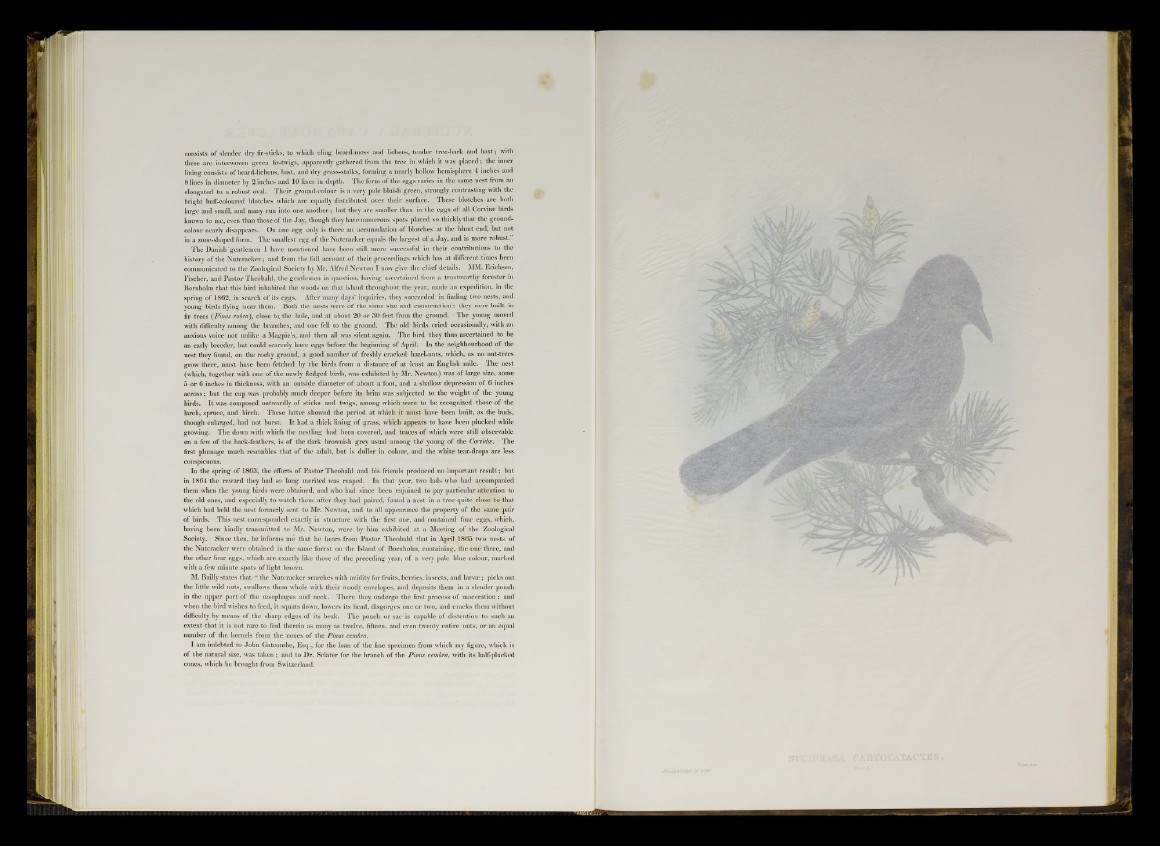
consists of slender dry fir-sticks, to which cling beard-moss and lichens, tender trce-bark and bast; with
these are interwoven green fir-twigs, apparently gathered from the tree in which it was placed; the inner
lining consists of beard-lichcns, bast, and dry grass-stalks, forming a nearly hollow hemisphere 4 inches and
8 lines in diameter by 2 inches and 10 lines in depth. The form of the eggs varies in the same nest from an
elongated to a robust oval. Their ground-colour is a very pale bluish green, strongly contrasting with the
bright buff-coloured blotches which are equally distributed over their surface. These blotches are both
large and small, and many run into one another; but they are smaller than in the eggs of all Corvine birds
known to me, even than those of the Jay, though they have numerous spots placed so thickly that the groundcolour
nearly disappears. On one egg only is there an accumulation of blotches at the blunt end, but not
in a zone-shaped form. The smallest egg of the Nutcracker equals the largest of a Jay, and is more robust.”
The Danish'gentlemen I have mentioned have been still more successful in their contributions to the
history of the Nutcracker; and from the full account of their proceedings which has at different times been
communicated to the Zoological Society by Mr. Alfred Newton I now give the chief details. MM. Erichsen,
Fischer, and Pastor Theobald, the gentlemen in question, having ascertained from a trustworthy forester in
Bornholm that this bird inhabited the woods on that island throughout the year, made an expedition, in the
spring of 1862, in search of its eggs. After many days’ inquiries, they succeeded in finding two nests, and
young birds flying near them. Both the nests were of the same size and construction: they were built, in
fir trees (Pi/jms rubra), close to. the bole, and at about 20 or 30 feet from the ground. The young moved
with difficulty among the branches, and one fell to the ground. The old birds cried occasionally, with an
anxious voice not unlike a Magpie’s, and then all was silent again. The bird they thus ascertained to be
an early breeder, but could scarcely have eggs before the beginning of April. In the neighbourhood of the
nest they found, on the rocky ground, a good number of freshly cracked hazel-nuts, which, as no nut-trees
grow there, must have been fetched by the birds from a distance of at least an English mile. The nest
(which, together with one of the newly fledged birds, was exhibited by Mr. Newton) was of large size, some
5 or 6 inches in thickness, with an outside diameter of about a foot, and a shallow depression of 6 inches
across; hut the cup was probably much deeper before its brim was subjected to the weight of the young
birds. It was composed outwardly of sticks and twigs, among which were to he recognized those of the
larch, spruce, and birch. These latter showed the period at which it must have been built, as the buds,
though enlarged, had not burst. It had a thick lining of grass, which appears to have been plucked while
growing. The down with which the nestling had been covered, and traces of which were still observable
on a few of the back-feathers, is of the dark brownish grey usual among the* young of the Corvidce. The
first plumage much resembles that of the adult, but is duller in colour, and the white tear-drops are. less
conspicuous.
In the spring of 1863, the efforts of Pastor Theobald and his friends produced no important result; but
in 1864 the reward they had so long merited was reaped. In that year, two lads who had accompanied
them when the young birds were obtained, and who had since been enjoined to pay particular attention to
the old ones, and especially to watch them after they had paired, found a nest in a tree quite close to that
which had held the nest formerly sent to Mr. Newton, and to all appearance the property of the same pair
of birds. This nest corresponded exactly in structure with the first one, and contained four eggs, which,
having been kindly transmitted to Mr. Newton, were by him exhibited at a Meeting of the Zoological
Society. Since then, he informs me that he hears from Pastor Theobald that in April 1865 two nests of
the Nutcracker were obtained in the same forest on the Island of Bornholm, containing, the one three, and
the other four eggs, which are exactly like those of the preceding year, of a very pale blue colour, marked
with a few minute spots of light brown.
M. Bailly states that “ the Nutcracker searches with avidity for fruits, berries, insects, and larvae; picks out
the little wild nuts, swallows them whole with their woody envelopes, and deposits them in a slender pouch
in the upper part of the oesophagus and neck. There they undergo the first process of maceration ; and
when the bird wishes to feed, it squats down, lowers its head, disgorges one or two, and cracks them without
difficulty by means of the sharp edges of its beak. The pouch or sac is capable of distention to such an
extent that it is not rare to find therein as many as twelve, fifteen, and even twenty entire nuts, or an equal
number of the kernels from the cones of the Pinus cembra.
I am indebted to John Gatcombe, Esq., for the loan of the fine specimen from which my figure, which is
of the natural size, was taken ; and to Dr. Sclater for the branch of the Pinus cembra, with its half-plucked
cones, which he brought from Switzerland.